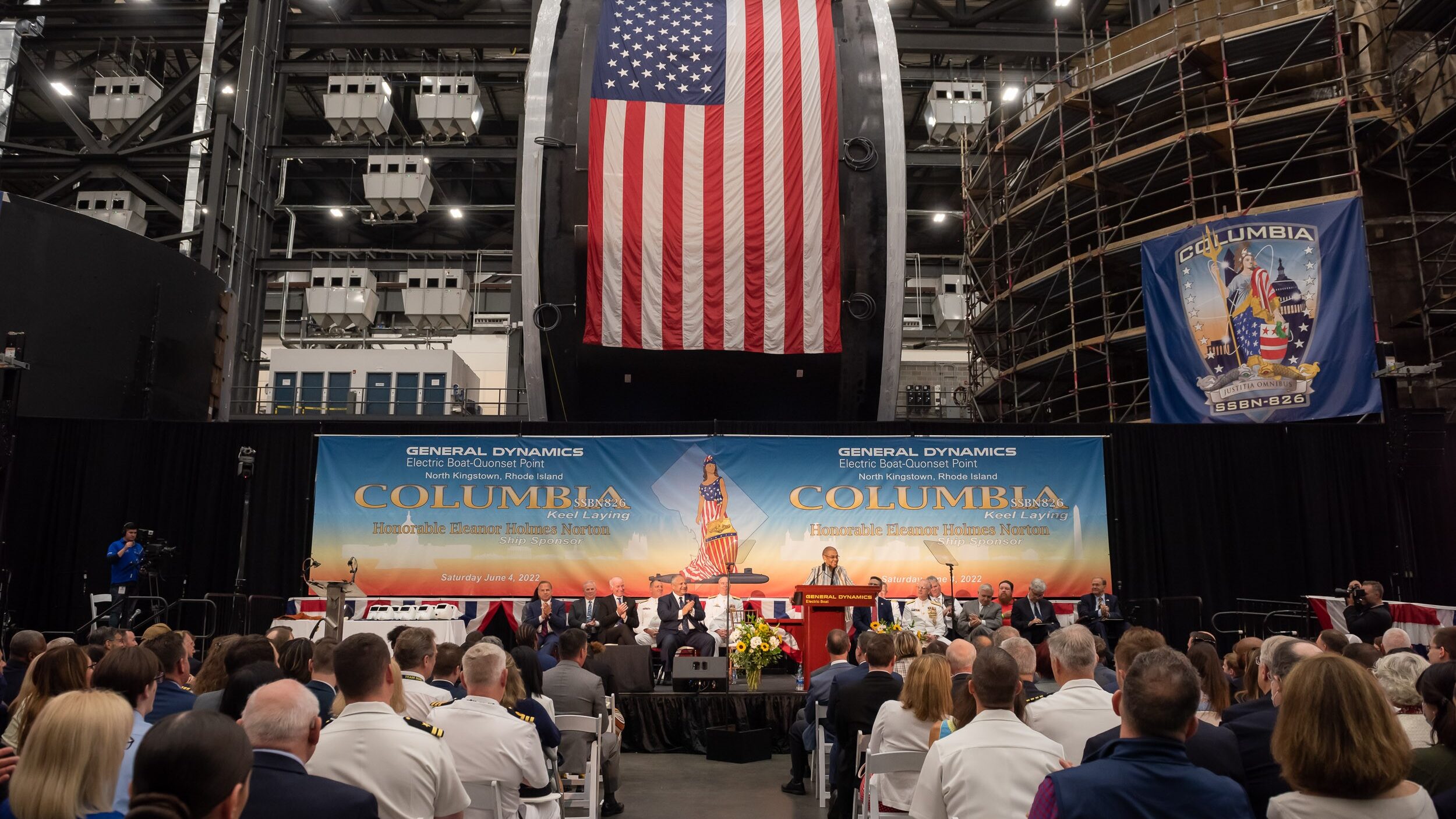
Washington D.C. Congresswoman Eleanor Holmes Norton speaks during the keel laying ceremony for the future USS District of Columbia. (Photo courtesy of General Dynamics Electric Boat)
Updated 4/11/2024 at 8:00am ET to include a statement from Northrop Grumman.
WASHINGTON — One of the “most significant” drivers of schedule delays on the Navy’s new Columbia-class ballistic missile submarines is slow deliveries of a turbine generator made by Northrop Grumman, the Navy’s top civilian said today.
“That has had a major impact on the delay of the Columbia,” said Navy Secretary Carlos Del Toro during a House Appropriations defense subcommittee hearing.
Earlier this month, the Navy acknowledged that the delivery of the first Columbia-class submarine — the Navy’s top acquisition priority — is projected to be between 12 and 16 months late. The Columbia class is built jointly by General Dynamics Electric Boat and HII.
“Northrop Grumman is fully committed to the Columbia-class program, and is fully supportive of General Dynamics Electric Boat and the US Navy as we work to together to deliver this program,” a Northrop Grumman spokesperson said in a statement, which referred questions to GD Electric Boat.
The Navy’s latest schedule estimates were made as part of a 45-day review of Navy shipbuilding programs ordered by Del Toro in January, which found four major programs anywhere from one to three years behind schedule.
Some of the challenges impacting Columbia are common among all of the shipbuilding programs suffering delays, such as material shortages that are still lingering in the wake of the COVID-19 pandemic, Del Toro said. He noted that the most significant challenge is shipyards’ ability to recruit and retain a blue-collar workforce to build the ships.
“We have one shipyard in particular who has an extremely low retention rate. And so we’re trying to work with that shipyard to improve the retention rate actually, by even giving bonuses to potential workers: $5,000 for the first year and $5,000 if they stay at the shipyard by the delivery of the first ship,” he said.
The Navy’s review has rankled lawmakers, both inside the appropriations committees that control the federal government’s purse strings and outside.
Oklahoma Rep. Tom Cole, who will help steer the fiscal 2025 spending bill as the newly-appointed House Appropriations Committee chairman, told Navy leaders he was “particularly troubled” by the findings of the 45 day review as the delayed programs “are vital to countering China in the Pacific.”
Rep. Ken Calvert, R-Calif., who chairs the committee’s defense panel, questioned whether Navy leadership had lost its way on the Columbia-class program.
“Congress has funded every dollar requested for this program. Now it is delayed by at least a year, leaving no more margin for failure for the rest of the decades-long procurement and delivery schedule,” he said in opening remarks.
As Navy leadership testified on Capitol Hill, Sen. Roger Wicker, the top Republican on the Senate Armed Services Committee, issued a statement raising concerns over the Navy’s shipbuilding plan and 45 day review, criticizing the Navy for a “lack of bold recommendations and funding requirements” to get programs back on track.
“Congress has prevented the Biden administration from rapidly shrinking the Navy, but the White House has now asked once more to cut the Navy down to 280 ships. This trajectory puts even more risk on our sailors’ backs,” Wicker said. “It is clear that Congress will again need to act to prevent early ship retirements and provide sailors with the platforms they need to win.”
Del Toro said Tuesday at the Sea Air Space conference that the Navy’s office of strategic assessment would conduct a second study seeking “opportunities for improvement” for future shipbuilding procurement.
Parsons, Rafael team up on competition to defend Marine bases from small drones
The two companies will likely have stiff competition in a tech space that has proven vital for the wars both in Ukraine and Israel.


























